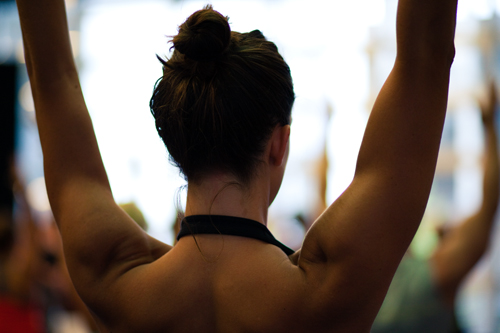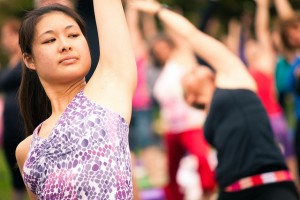Are your dancers fit?
Generally we think of dancers as being physically fit, but today most of us in the dance field recognize that there are ‘holes’ in typical dance training. Technique classes alone are not enough for the demands of present-day choreography.

Though your dancers may not yet be professionals, if they are studying seriously or competing often they are artistic athletes in training. Conditioning or fitness training can be added to fill any holes, preventing injury and enhancing performance.
In September, I participated in a workshop in Houston, facilitated by Sarah Irvine, a former faculty member of the Dance Science Departments at Laban and Roehampton University. The workshop was an opportunity to participate in and discuss the development of a fitness class, part of a program designed by the Laban Dance Fitness Team to support dancers which has been successfully implemented in programs for career-focused dancers. [This pdf details some of the research conducted by Irvine and the team]
Cardiorespiratory Endurance
My maximum heart rate:
220 – 33 (my age) = 187
My target heart rate zone:
126 to 153 (70 – 85% of max heart rate)
The cardio component of the 2-hour workshop consisted of a 5-10 minute warm-up and more than 30 minutes of continuous aerobic exercise designed to keep us in our target heart rate (which for dancers is 70-85% of your maximum heart rate: approximately your age subtracted from 220).
What most distinguished this routine from most other aerobics, or aerobic dance classes I’ve experienced was the increased use of multidimensional movement, familiar dance vocabulary, and dynamics like suspension and fall.
These exercises were carefully selected and rooted in dance and exercise science and I am hoping that the fitness team at Laban might make available some suggested fitness routines in the future. I sadly did not notate the exercises well enough to share with you, however, I will say that what we did actually reminded me a great deal of the Nia classes I’ve taken, and my college jazz dance classes.
My college professor’s extended warm-up for our class was always at least 20-30 minutes of continuous movement that progressed from smaller steps (ball change, marches/walking) to larger full-body steps (chassé or lindy, jazz square) with increasing involvement of the torso and arms. It’s a method I’ve stolen for my own jazz classes – once students know the basic steps, I keep them moving for added aerobic benefit, making it more or less complex based upon experience level.
Cardiorespirtory endurance is the component of fitness probably least addressed in technique classes. Dancers don’t get much cardio until they are deep into rehearsals and performance – too little, too late, they may lack the stamina required for the performance (which can lead to injury). You may not have a science team behind you, but consider adding some cardio to your students’ training.
DO:
- Think about ways you can use direction changes, upper body and torso, and dynamics.
- Make sure you include a warm-up and cool-down period (5-10 minutes each).
- Once the blood is pumping, keep the intensity going for at least 20 minutes and your students will get some added aerobic exercise in their week.
- Have students monitor their heart rate before and after. They can note it in a dance journal to keep track of their progress .
- Ask yourself – Is it possible to include aerobic exercise more frequently, before rehearsal, as a special class? Is it possible to adapt the series and use a more contemporary or modern or tap or ballet vocabulary?
Prescription: For dancers who need to improve cardiovascular fitness, 20-45 minutes of aerobic exercise 3-7 times per week (less during the peak of performance season; more in the off-season to avoid over-training and overuse injuries) is recommended. You may not be able to fulfill a student’s needs entirely at the dance studio so encourage students in other activities like walking, jogging, cycling, stair climbing, or swimming outside of class.
Power
In addition to the cardio workout, Ms. Irvine also had us experiment a bit with anaerobic exercises. These least resembled dance, however, the inclusion of such work has been shown to improve speed and strength – important for dancers and particularly helpful with jumping.
Suggested exercise modes for increasing a dancer’s power include sprint training, interval training, plyometrics, and dance specific repetitive movement phrases with faster, more dynamic movements (allegro, anyone?). On this day we tried the following:
- Maniac-style Interval Training – You got it, just like in Flashdance, the movie, we did fast-as-you-can running in place. We got into groups and did short bursts (I believe it was one minute), resting as each group took their turn.
- Standing Long Jump – Across the floor we performed two feet to two feet jumps with the goal of getting as much distance as we could (trying for one less than we did the last time across), and also to land as softly as we could using a deep parallel plié and swinging arms.
But where are the pointed toes? There’s power in the foot. What about turnout? Isn’t this undoing their training? I’m coaching dancers, not track and field! — This is not a replacement for traditional dance training methods but adds functional support for the physiological needs of dancers, who must be athletes as well as artists. In the program implemented by Laban, exercises were gradually modified to include turn out and more closely mimic dance jumps.
- Tuck Jumps – Fitting as many tuck jumps as possible into 30 seconds, spending as little time on the ground as possible (and no double bouncing). I found this one difficult – fast twitch is not my specialty but I’m a decent jumper when it comes to repetitive allegro. As I tried this it was absolutely clear to me how this could improve my height and explosiveness in jumps.
Prescription: For dancers who need to improve anaerobic fitness, speed, and strength, it is suggested that 4 to 12 dynamic speed training exercises (using full body weight as resistance) be selected and added to their training regime. Repeating 3 – 6 sets in 10 to 2 minute time frames (or 5 to 10 reps). The intensity should be moderate, with 2-5 minute rest periods between. This is not every day training. Two to three days per week is enough.
 Note that dancers will not have identical needs and that the prescriptions above must vary depending on a dancer’s deficit in certain areas of fitness. Dancers can be assessed for fitness and should be evaluated by a doctor before beginning a new fitness program. Though most exercises listed above could be facilitated by an experienced dance educator, any training program will be safer and more effective under the watch of a professional trainer or fitness expert.
Note that dancers will not have identical needs and that the prescriptions above must vary depending on a dancer’s deficit in certain areas of fitness. Dancers can be assessed for fitness and should be evaluated by a doctor before beginning a new fitness program. Though most exercises listed above could be facilitated by an experienced dance educator, any training program will be safer and more effective under the watch of a professional trainer or fitness expert.
In addition, I’d like to note that the prescriptions above come from a handout provided during the workshop. Cited as references on the handout are Bompa, T.,O. (1999). Periodization: Theory and methodology of training (4th ed.). Champaign, IL; Human Kinetics. and Hayward. V., H. (2002). Advance fitness assessment and exercise prescription (4th ed.). Champaign, IL; Human Kinetics.
Other than this worksheet, all other information is based upon my understanding, experience, and interpretation of the workshop material. I pass it on to you for informational purposes only. I’d like to get wheels turning, get you thinking and asking questions about fitness for your dancers. Do not, I repeat, do not consider any of the above as medical or health advice. And dancers, do not use this information to design your own fitness regime.
Stay tuned for part two of this article! In it, I’ll briefly go over four other components of fitness important to dancers, recap some exercises and tools Ms. Irvine discussed which are used to assess a dancer’s fitness, relay a word of caution for those working with young teens, and share a stockpile of helpful links and resources on the subjects of dance science, fitness, and wellness for dancers.
What are your challenges to addressing the fitness needs of dancers at your school?
Do you incorporate any of the above into your training regime?
What are some other ways you include aerobic and anaerobic fitness training in or outside of dance training?
Nichelle Suzanne is a writer specializing in dance and online content. She is also a dance instructor with over 20 years experience teaching in dance studios, community programs, and colleges. She began Dance Advantage in 2008, equipped with a passion for movement education and an intuitive sense that a blog could bring dancers together. As a Houston-based dance writer, Nichelle covers dance performance for Dance Source Houston, Arts+Culture Texas, and other publications. She is a leader in social media within the dance community and has presented on blogging for dance organizations, including Dance/USA. Nichelle provides web consulting and writing services for dancers, dance schools and studios, and those beyond the dance world. Read Nichelle’s posts.

